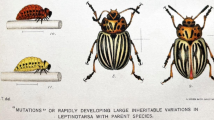Abstract
Decline of allozyme variability in 7 laboratory populations ofAphidius ervi Haliday demonstrates that the effective population size is approximately one half the number of individuals used to renew the cultures each generation. Unequal reproductive contribution by individual females to subsequent generations is the most likely cause for this phenomenon.
Résumé
La diminution de la variabilité des allozymes dans 7 populations de laboratoire deAphidius ervi Haliday montre que l'importance des effectifs des populations correspond approximativement à la moitié du nombre d'individus utilisés pour renouveler l'élevage à chaque génération. Une participation inégale à la reproduction des individus femelles aux générations successives est la cause la plus probable de ce phénomène.
Similar content being viewed by others
References
Ayala, F.J., Powell, J.R., Tracey, M.L., Mourao, C.A., &Perez-Salas, S. —1972. Enzyme variability in theDrosophila willistoni group. IV. Genic variation in natural populations ofDrosophila willistoni. —Genetics, 70, 113–139.
Baker, J.L. — 1976. Determinants of host selection for species ofAphytis [Hymenoptera: Aphelinidae], parasites of diaspine scales. —Hilgardia, 44, 1–25.
Crozier, R.H. — 1976. Counter-intuitive property of effective population size. —Nature, 262, 384.
Flanders, S.E. — 1931. Temperature relationship ofTrichogramma minutum as a basis for racial segregation. —Hilgardia, 5, 395–406.
Gonzalez, D., Gordh, G. Thompson, S.N. &Adler, J. — 1979. Biotype discrimination and its importance to biological control. In: Genetics in Relation to Insect Management. (M. Hoy &J. McKelvey eds.) —The Rockefeller Foundation, New York, 129–136.
Gonzalez, D., White, W., Hall, J. &Dickson, R.C. — 1978. Geographic distribution ofAphidiidae [Hym.] imported to California for biological control ofAcyrthosiphon kondoi andAcyrthosiphon pisum [Hom.: Aphididae] —Entomophaga, 23, 239–248.
Harris, H. &Hopkinson, D.A. — 1976. Handbook of Enzyme Electrophoresis in Human Genetics. —American Elsevier Publishing Co., New York.
Hoy, M.A. — 1978. Variability in diapause attributes of insects and mites: Some evolutionary and practical implications. In. The Evolution of Insect Migration and Diapause. (H. Dingle ed.). —Springer-Verlag New York, 101–126.
Kerr, W.E. &Wright, S. — 1954. Experimental studies of the distribution of gene frequencies in very small populations ofDrosophila melanogaster. —Evolution, 8, 172–177.
Klun, J.A. &Maini, S. — 1979. Genetic basis of an insect chemical communication system: The European corn borer. —Environ. Entomol., 8, 423–426.
Lanier, G.N., Closson, A., Stewart, T., Piston, J.J. &Silverstein, R.M. —— 1980.Ips pini: The basis for interpopulation differences in pheromone biology. —J. Chem. Ecol., 6, 677–687.
Leppla, N.C., Huettel, M.D. Chambers, D.L. &Turner, W.K. — 1976. Comparative life history and respiratory activity of “wild” and colonized Caribbean fruit flies [Dipt.: Tephritidae]. —Entomophaga, 21, 353–357.
Lewontin, R.C. — 1974. The Genetic Bases of Evolutionary Change. —Columbia University Press, New York & London, 346 pp.
Li, C.C. — 1976. First Course in Population Genetics. —Boxwood Press. 631 pp.
Mackauer, M. — 1972. Genetic aspects of insect production. —Entomophaga, 17, 27–48.
Mackauer, M. — 1976. Genetic problems in the production of biological control agents. —Annu. Rev. Entomol., 21, 369–385.
Muruyama, T. — 1970. On the rate of decrease of heterozygosity in circular stepping stone models of populations. —Theor. Pop. Biol., 1, 101–119.
Nagarkatti, S. — 1979. Experimental comparison of laboratory-reared vs. wild-typeTrichogramma chilonis [Hym.: Trichogrammatidae]. II Tolerance of non-optimal temperatures. —Entomophaga, 24, 417–421.
Nagarkatti, S. &Nagaraja, H. — 1978. Experimental comparison of laboratory reared vs. wildtypeTrichogramma confusum [Hum.: Trichogrammatidae]. I Fertility, fecundity and longevity. —Entomophaga, 23, 129–136.
Nei, M., Muruyama, T. &Chakraborty, R. — 1975. The bottleneck effect and genetic variability in populations. —Evolution, 29, 1–10.
Pamilo, P., Varvio-Aho, S. &Pekkarinen, A. — 1978. Low enzyme gene variability in Hymenoptera as a consequence of haplodiploidy. —Hereditas, 88, 93–99.
Prout, T. — 1954. Genetic drift in irradiated experimental populations ofDrosophila melanogaster. —Genetics, 39, 529–545.
Selander, R.K., Smith, M.H. Yang, S.Y., Johnson, W.E. &Gentry, J.B. — 1971. Biochemical polymorphism and systematics in the genusPeromyscus I. Variation in the old-field mouse (Peromyscus polionotus). —Univ. Tex. Publ., 7103, 46–90.
Shaw, C.R. &Prassad, R. — 1970. Starch gel electrophoresis—A compilation of recipes. —Biochem. Genet., 4, 297–320.
Skinner, S.W. — 1982. Maternally inherited sex ratio in the parasitoid waspNasonia vitripennis. —Science, 215, 1133–1134.
Spiess, E.B. — 1977. Genes in Populations. —Wiley, New York, 779 pp.
Wright, S. — 1951. The genetical structure of populations. —Ann. Eugen., 15, 323–354.
Wright, S.— 1980. Genic and organismic selection. —Evolution, 34, 825–843.
Author information
Authors and Affiliations
Rights and permissions
About this article
Cite this article
Unruh, T.R., White, W., Gonzalez, D. et al. Heterozygosity and effective size in laboratory populations ofAphidius ervi [Hym.: Aphidiidae] . Entomophaga 28, 245–258 (1983). https://doi.org/10.1007/BF02372175
Issue Date:
DOI: https://doi.org/10.1007/BF02372175




